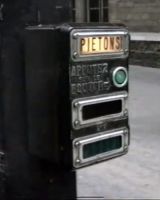

TRT REMU
static electronics
1970s
copy kept at the LER

Garbarini M158
electromechanical
middle of 1960s

Silec VDP
electromechanical
middle of 1960s
copy kept at the LER
TRAFFIC CONTROLLERS

incandescence
unknow manufacturer
1960s

incandescence (Ø160)
unknow manufacturer
since 1950s
NEW PEDESTRIAN PUSH BUTTONS
NEW REPEATERS

incandescence
1970s

Théry Hindrick
1970s
2nd generation of Parisian traffic light since 1950s



Silec signal disabled
Concord Bridge
2018

Silec Standard model in steel
Pont au Change
1969

Model Silec Europe
rue de Crimee lift bridge

In Paris, if automobile traffic was already very intense in the 1960s, river traffic was already just as intense. And to regulate the latter as well as possible, and to signal the state of the various movable bridges and locks installed on the Seine and the various Parisian canals, what could be better than traffic lights ? This is how many Silec Standard traffic lights with fluorescent tubes were fixed on the Parisian bridges, responsible for indicating whether passage under the bridges was authorised. Only one copy of these signals from the 1960s still survives today, long since extinct.
The rue de Crimée lift bridge, inaugurated in 1885, was equipped with many Europe traffic lights from the manufacturer Silec : 3 signals on either side of the bridge for boats, and on the road side not Parisian traffic lights but always Europe signals . A flashing red signal for cars, and a pedestrian signal fixed directly to the barriers of the bridge, all doubled on either side of the roadway. All these signals were filed only in 2011.
The installation of such signals on the public highway in Paris is explained by the fact that the signaling of these bridges is managed by the service of the canals of Paris which depends on the Department of roads and travel.
RIVER SIGNALS

Théry Hindrick N.A.
around 1974
last copies in place in 2013
Gambetta crossroads, 1990
Trinité signals on mast in middle of roadway




In the 1970s, a single-colour miniature signal was used to signal obstacles : edges of roundabouts, central islands, lighting poles ocated in the middle of crossroads, etc. They were made by the manufacturer Girardin under the name Trinité, which also marketed them to manufacturers of automatic doors. They are still found today at certain intersections in Paris, all switched off, and more surprisingly above certain garage doors.
They are the heirs of the copper model designed by this same manufacturer in the 1940s (see section 1940>1950).
TRINITÉ SIGNALS

DOUBLE PEDESTRIAN SIGNALS
The visibility of pedestrian signals with incandescent lamps is sometimes lacking, especially when they are exposed to the sun, and this is all the more true on the main Parisian boulevards, where the traffic lights are sometimes several tens of meters apart. To overcome this problem of visibility, the pedestrian signals were doubled from the 1970s : a signal on the pavement side, then another on the side of the pedestrian crossing. In this way, pedestrians only had to look up before crossing to know the status of the traffic light intended for them.
This practice disappeared with the arrival of LED pedestrian signal in the late of 1980s.
NEW PEDESTRIAN SIGNAL
MODEL OF TRAFFIC LIGHT
Place des fêtes, 1978
Place des fêtes, 1977


At the end of the 1970s, the Place des Fêtes, located in the 19th arrondissement, was completely renovated. Residential towers are built there, and its development is studied in the smallest details.
As such, street furniture is meticulously studied. The Ville Nouvelle traffic lights from the Lille manufacturer Théry Hindrick were chosen, in particular to harmonize with the public lighting in the shape of a half-sphere (Roissy model from the manufacturer Philips). The entire Place des Fêtes district will be equipped with this model launched in 1973, which contrasts sharply with the historic Parisian models. The same model will again be installed on another Parisian crossroads in the 1990s.
PLACE DES FÊTES
Former mast with agent box at Porte de Bercy in 2017

Central painted ground signal in 1992

The signals of the Porte d'Italie tunnel in 1973

An alarm pull in the Alma tunnel in 2018

In 1976, more than 1000 intersection controllers were in service in Paris, using two different technologies:
- 800 electromechanical controllers
- 200 electronic controllers
The Paris ring road, an urban highway encircling the capital, was inaugurated in April 1973. It has been fitted with numerous traffic lights.
First of all, each tunnel was equipped upstream with a traffic light on either side of the roadway. These traffic lights were connected to switches called alarm pulls inside the underground passages. When a motorist was in difficulty in the tunnel (breakdown or accident), it could set off the alarm, which caused the passage of the underground traffic lights to red, and thus stopped traffic on the ring road. Identical systems have been installed in all the underground routes in Paris. This device actually turned out to be totally useless because no one respected these signals which were not centralized and could stay red for weeks without anyone worrying about it. They were finally all filed between 1994 and 1996.
Other traffic lights have been placed at the entrances to each door of the ring road. They functioned permanently with flashing yellow and were triggered with red when closing the peripheral thanks to a switch placed in an agent box. These signals were also removed in the late 1990s, but poles still remain.
THE PERIPHERAL BOULEVARD
In the 1960s, when the complex at the crossroads of the Quai Branly and the Pont d'Iéna was modernized, light-based pole, the famous square posts installed throughout Paris for mid-road signals (see above), have been shortened.
Deemed too high and detrimental to the visibility and enhancement of the Old Lady, a planed version was therefore installed specifically for this intersection.



From the 1930s and the appearance of the three-colour signal, rear repetition of the signal was generalized at all intersections. Although this has long been considered useful for giving an indication of signal status to users of the opposite lane, it sometimes adds more confusion than real utility.
Experiments were therefore carried out by the services of the city of Paris. In addition to the pure and simple disappearance of the second side of the signals, an alternative solution has been found. The repeated signals on the rear face are obscured to let in only a slight thread of light in the form of a small cross. The red signal is left intact.
This attenuated repetition will inspire the creation of the Greek cross, adopted in 1991, and now the only authorized rear repetition. However, Parisian signals witnessing these experiments of the 1970s, will remain in place until the 2010s.
The Thery Hindrick model adopted in the early 1970s
The old model with inscriptions of the manufacturer EVR


It was in 1974 that French pedestrian signals were modernized. Until then, signals that include the inscriptions "ATTENDEZ" and "PASSEZ" are used. But for the sake of understanding and harmonization, pedestrian signals will now be in the form of two pictograms : a motionless pedestrian in front for red, and a moving pedestrian in profile for green.
These are the pedestrian signals of the Lille manufacturer Théry Hindrick which will be chosen by the city of Paris, probably after a draconian selection operated by the street equipment laboratory (LER) in charge of testing Parisian street furniture.
A new pole with a luminous base on a Devaux base.
Pont de la Tournelle crossroads, 1968 (JHM collection).

In the mid-1960s, a new type of pole will appear. It is a trapezoidal pole, whose white base consists of a 4-sided plexiglas behind which there is a fluorescent tube. It is further reinforced by reflectors. The upper part of the pole is Paris brown. This type of pole is fixed on a round concrete base called a Devaux plinth. The upper traffic light is fixed at the top of the pole, i.e. from below, directly by an integrated screw thread on the top of the pole.
These new light-based pole, specially designed for the city of Paris, are used to enhance the visibility of traffic lights located in the middle of the roadway, particularly on the wide Parisian boulevards. This model nicknamed "potelet carré", or "potelet Mazas" is still used today in Paris and manufactured by the sheet metal company Bowden SAS.
Paris, 1963
© archives Alinari

In 1963, an experiment with a countdown signal for pedestrians was carried out by the Parisian traffic services. This is a signal that tells pedestrians the remaining time to cross (equivalent to the red car time).
This signal remains unique and very precursory for the time. Even press agencies will make the trip to immortalize it, but it will not be generalized.
Other experiments with down-counter signals will take place later, with as much success as they will all be deposited.




CHANGE BACKWARD REPEAT
The events of May 1968, during which numerous riots were to take place, were to have consequences on the state of traffic lights in Paris.
Many pole will be torn down and laid down to form the barricades, and those still standing will be badly damaged. The return to normal will only occur at the very end of May.
PEDESTRIAN SIGNS WITH PICTOGRAMS
THE REDUCED POLE OF THE EIFFEL TOWER
EXPERIMENTATION OF THE PEDESTRIAN COUNTER
NEW LIGHT-BASED POSED
MAY 1968
The decade of 1970 will mark a turning point in modernity in the Parisian traffic lights : commissioning of the ring road, new pedestrian signal, urban renewal...
This decade will also see the birth of a technology that will revolutionize traffic regulation in Paris : electronic controllers.
The 1960s was marked by the continuation of the extension of traffic regulation in Paris, which was nevertheless slowed down by the events of 1968 which were to have a considerable impact on Parisian urban planning.
A visionary experiment, although not conclusive, will still take place in 1963 (read below).
1960 - 1970
Parisian's signals



the website
about
French traffic lights



©2006-2023 | Conception : Hugo MAILLET - all rightd reserved | Companies and brands represented belong to their respective owner